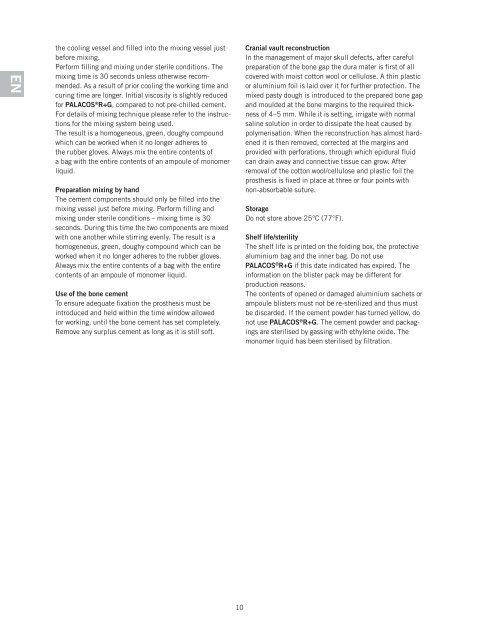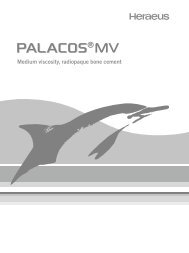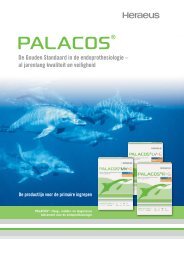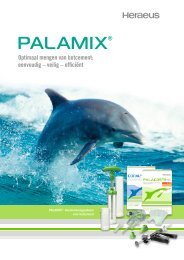griego - Heraeus Medical: Bone Cement
griego - Heraeus Medical: Bone Cement
griego - Heraeus Medical: Bone Cement
You also want an ePaper? Increase the reach of your titles
YUMPU automatically turns print PDFs into web optimized ePapers that Google loves.
EN<br />
the cooling vessel and filled into the mixing vessel just<br />
before mixing.<br />
Perform filling and mixing under sterile conditions. The<br />
mixing time is 30 seconds unless otherwise recommended.<br />
As a result of prior cooling the working time and<br />
curing time are longer. Initial viscosity is slightly reduced<br />
for PALACOS ® R+G, compared to not pre-chilled cement.<br />
For details of mixing technique please refer to the instructions<br />
for the mixing system being used.<br />
The result is a homogeneous, green, doughy compound<br />
which can be worked when it no longer adheres to<br />
the rubber gloves. Always mix the entire contents of<br />
a bag with the entire contents of an ampoule of monomer<br />
liquid.<br />
Preparation mixing by hand<br />
The cement components should only be filled into the<br />
mixing vessel just before mixing. Perform filling and<br />
mixing under sterile conditions – mixing time is 30<br />
seconds. During this time the two components are mixed<br />
with one another while stirring evenly. The result is a<br />
homogeneous, green, doughy compound which can be<br />
worked when it no longer adheres to the rubber gloves.<br />
Always mix the entire contents of a bag with the entire<br />
contents of an ampoule of monomer liquid.<br />
Use of the bone cement<br />
To ensure adequate fixation the prosthesis must be<br />
introduced and held within the time window allowed<br />
for working, until the bone cement has set completely.<br />
Remove any surplus cement as long as it is still soft.<br />
10<br />
Cranial vault reconstruction<br />
In the management of major skull defects, after careful<br />
preparation of the bone gap the dura mater is first of all<br />
covered with moist cotton wool or cellulose. A thin plastic<br />
or aluminium foil is laid over it for further protection. The<br />
mixed pasty dough is introduced to the prepared bone gap<br />
and moulded at the bone margins to the required thickness<br />
of 4–5 mm. While it is setting, irrigate with normal<br />
saline solution in order to dissipate the heat caused by<br />
polymerisation. When the reconstruction has almost hardened<br />
it is then removed, corrected at the margins and<br />
provided with perforations, through which epidural fluid<br />
can drain away and connective tissue can grow. After<br />
removal of the cotton wool/cellulose and plastic foil the<br />
prosthesis is fixed in place at three or four points with<br />
non-absorbable suture.<br />
Storage<br />
Do not store above 25°C (77°F).<br />
Shelf life/sterility<br />
The shelf life is printed on the folding box, the protective<br />
aluminium bag and the inner bag. Do not use<br />
PALACOS ® R+G if this date indicated has expired. The<br />
information on the blister pack may be different for<br />
production reasons.<br />
The contents of opened or damaged aluminium sachets or<br />
ampoule blisters must not be re-sterilized and thus must<br />
be discarded. If the cement powder has turned yellow, do<br />
not use PALACOS ® R+G. The cement powder and packagings<br />
are sterilised by gassing with ethylene oxide. The<br />
monomer liquid has been sterilised by filtration.






